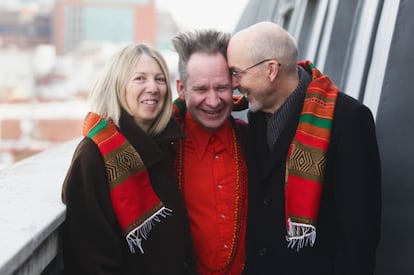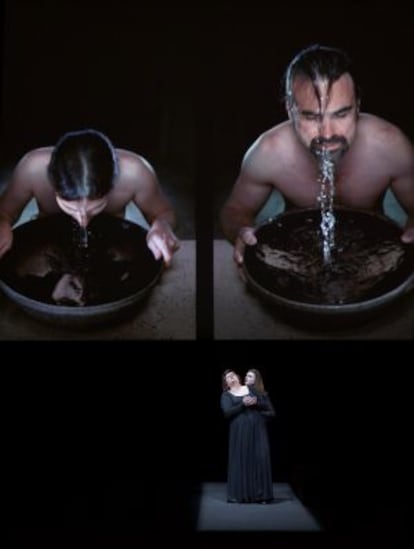Wagner in the world of video art
New take on 'Tristan and Isolde' incorporates composer's interest in Buddhism

Tristan and Isolde required going beyond the work itself. So, at least, was the opinion of video creator Bill Viola, theater director Peter Sellars and former Teatro Real chief Gerard Mortier. A decade ago, all three embarked on a groundbreaking project to revolutionize the legendary love story that Richard Wagner turned into an opera between 1857 and 1859.
The result is a production in which video art and Wagner's transgressive score expand on the original story while shedding light on forgotten facts, such as the German composer's interest in Buddhism while he was working on this opera.
The production became one of the watershed moments in the career of Gerard Mortier, a controversial figure who was no longer at the helm of the Spanish opera house when it premiered there this past Sunday (he was fired in September, shortly after stating in EL PAÍS that if the Spanish government appointed someone he did not approve of as his successor, he would walk out before the end of his contract).
Sellars, Viola and Kira Perov, Viola's partner and producer, sat down shortly before the Spanish premiere to discuss the origins of the project and their particular vision of opera, contemporary art and the use of new technologies to make art more dynamic.
This piece is about the love between two people who hate each other"
Question. How did this project begin?
Peter Sellars. Bill and Kira asked me to work with them on the retrospective of Bill Viola's 25-year career, and ever since then they have become a part of my life. The seed for this project began in L.A. with [Finnish conductor] Esa-Pekka Salonen. Mortier was in talks with Salonen back then and the project just came together. It wasn't about getting to Tristan and Isolde from the 19th century, but through Alban Berg or Debussy. We wanted it to be listened to with modern ears. When he wrote it, Wagner said he was creating his Buddhist work. That was an amazing thing back then. Kira and Bill had a Zen master and they lived in Japan for a period while they were learning. A dialogue with them meant that the piece could make the jump to a dreamed-of place.

Bill Viola. The problem many people have is that they keep focusing on the same thing they knew at a certain time in their lives. What Wagner asks of us as a first step is to move beyond that. Besides, this work is able to absorb modern technology.
Q. What was the initial reaction to the proposal?
B. V. A no! A 19th-century German Romantic with a 20th-century video artist? No way. But it was fantastic. What Wagner intuitively understood is that all this is about trying to connect elements that already existed. And now we can do that in all directions. That is the Buddhist experience. All the universe is a globe that is connected.
Q. What lessons can be drawn from this work today?
P. S. One of them is based on oppositions. The play of opposites between night and day, man and woman, life and death... What it teaches us is that everything is completed by its opposite. But the struggle is intense. Yet in the end everything revolves around plenitude. This piece is about the love between two people who hate each other. That's the way humans are. You don't understand life until you sit down with someone who is dying. This piece also talks about the changes introduced in your world by love and death. Wagner made it last all of five hours, so you cannot just saunter through it. In a way, it always changes you. And it is uncomfortable: people kill themselves trying to sing it, for the orchestra it is extremely hard... It pushes everyone to their limits. But you have to go further, as Bill says.
The conversation turns to the possibility of democratizing culture and opera through technology, and also to the price of opera tickets, which Viola complains about. Sellars explains to him the 13 percent VAT hike rise on cultural products introduced by the Spanish government last year.
P. S. They are trying to liquidate art and ensure that the audience for it will be limited. Today's dress rehearsal is the only way that many people will be able to see this show. Art is being treated like a luxury. The crisis is being used as an excuse to destroy the arts and return them to a small group of people. Returning them to the provinces. And that is because art is a democratic force.
Q. Do you feel that while the internet connects us, it also makes us more superficial?
P. S. The bad thing about the way our capitalist society is organized is that there are just a few creative minds and the rest do all the gray work. That is why people need a break from their horrible jobs. The good thing about technology is that it has put these possibilities at the fingertips of the population in a good sense. The more people there are doing creative things, the better. But what we do in theater, or at the museum, is a whole other story. A group of people who charge for something that the others cannot do for lack of time, money or talent, to go much further. Now there is an entire generation of artists who are involved in political, medical and social matters... And they are looking for creative solutions. They make deeply useful art. These days many of the great problems of society are resolved in the realm of art, because politicians have given up and our laws are useless. Take immigration, for instance. The law is useless and it does not help. It should be a cultural issue. As the political world gets paralyzed and makes increasingly stupid decisions, people will start dealing with those controversial issues as cultural matters. We are going through a very painful moment in the history of politics, but very fertile in art. It's not about what we like, but about what matters.
Q. Can opera respond to all these trends?
P. S. Opera, as it was conceived by Monteverdi, is a collaborative endeavor. It is a space where people from different places put something different on the table and build something much greater than what they could achieve individually. Opera is the art form of the future, not because of what this building represents, but because it is a metaphor for the future of this planet. Our problems will only be resolved by working collaboratively.
Tu suscripción se está usando en otro dispositivo
¿Quieres añadir otro usuario a tu suscripción?
Si continúas leyendo en este dispositivo, no se podrá leer en el otro.
FlechaTu suscripción se está usando en otro dispositivo y solo puedes acceder a EL PAÍS desde un dispositivo a la vez.
Si quieres compartir tu cuenta, cambia tu suscripción a la modalidad Premium, así podrás añadir otro usuario. Cada uno accederá con su propia cuenta de email, lo que os permitirá personalizar vuestra experiencia en EL PAÍS.
¿Tienes una suscripción de empresa? Accede aquí para contratar más cuentas.
En el caso de no saber quién está usando tu cuenta, te recomendamos cambiar tu contraseña aquí.
Si decides continuar compartiendo tu cuenta, este mensaje se mostrará en tu dispositivo y en el de la otra persona que está usando tu cuenta de forma indefinida, afectando a tu experiencia de lectura. Puedes consultar aquí los términos y condiciones de la suscripción digital.
Últimas noticias
From digital curfews to blocking apps: How technology experts protect their children online
Why the price of coffee has skyrocketed: from Brazilian plantations to specialty coffee houses
Confined to a Cuban hospital: When electricity is a matter of life or death
The complicated life of Francesca Albanese: A rising figure in Italy but barred from every bank by Trump’s sanctions
Most viewed
- Why we lost the habit of sleeping in two segments and how that changed our sense of time
- Trump’s obsession with putting his name on everything is unprecedented in the United States
- Pablo Escobar’s hippos: A serious environmental problem, 40 years on
- The Florida Keys tourist paradise is besieged by immigration agents: ‘We’ve never seen anything like this’
- Charles Dubouloz, mountaineering star, retires at 36 with a farewell tour inspired by Walter Bonatti









































